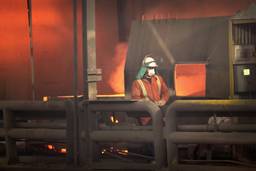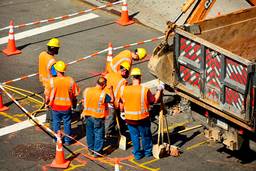Red, as in furiously red, defined the day last fall when a consortium of companies announced it wanted $450 million in U.S. stimulus money to build a wind farm in Texas, creating 2,000 jobs in China and 300 in America.
Now, nine months later, things have cooled down and turned around. In a deal with the United Steelworkers (USW), two Chinese companies have agreed to build as much of the wind turbines as possible in America, using American-made steel, and creating perhaps 1,000 American jobs.
The deal is a result of white collar Chinese executives negotiating with blue collar union officers to create green collar jobs in the U.S. The agreement defies stereotypes about unions as constantly combative, excessively expensive and environmentally challenged. The USW has a track record of engaging with enlightened CEOs for mutual benefit. It has a long green history. And it has worked to return off-shored jobs to the U.S.
The USW, like the Democrats in the House and Senate with their Make It in America program, is devoted to preserving and creating family-supporting, prosperity-generating manufacturing jobs in America. And if they’re green, all the better.
Billionaire investor Wilbur Ross has first-hand experience negotiating with unions, including the USW, to sustain U.S. manufacturing. He describes it positively. Here he is on PBS’ Charlie Rose on Aug. 2:
“I have found the leaders of big industrial unions, the steelworkers, the auto workers, they understand dynamics of industry at least as well as the senior management of the companies.”
Ross talked to Rose about dealing with the USW during the time when he was buying LTV Steel:
“We worked out a contract that took 32 job classifications down to five, changed work rules to make it more flexible and most important of all, we put in a blue collar bonus system…We became the most efficient steel company in America. We were making steel with less than one man hour per ton. The Chinese at the time were using six man hours per ton. We were actually exporting some steel to China.”
Ross accomplished that while paying among the highest wages for manufacturing workers in America.
The USW approached the Chinese companies that planned the $1.5 billion Texas wind farm, A-Power Energy Generation Systems Ltd. and Shenyang Power Group, the same way it did Ross. The meetings occurred with the help of U.S. Renewable Energy Group, a private equity firm that facilitates international financing and investment in renewable energy projects. Jinxiang Lu, chairman and chief executive of Shenyang Power, said talking to the union enabled him to see its “vision for win-win relationships between manufacturers and workers.”
For the USW, this deal means the Chinese firms will initially buy approximately 50,000 tons of steel manufactured in unionized American mills to fabricate towers and rebar for the 615 megawatt wind farm in Texas, will employ Americans at a wind turbine assembly plant to be built in Nevada, and will employ more American workers in green jobs at plants constructing the blades, towers and thousands of other wind turbine parts.
For the Chinese companies, the USW, the largest manufacturing union in America, will use its long list of industry contacts to help construct an American supply chain essential to amass the approximately 8,000 components in a wind turbine. The idea is to collaboratively create a solid manufacturing, assembly, component sourcing, and distribution system so that this team – the Chinese companies, U.S. Renewable Energy Group and the USW — will build many more wind farms after the first in Texas.
Additional wind farms mean more renewable energy freeing the U.S. from reliance on foreign oil. As U.S. Sen. Sherrod Brown, D-Ohio, says, there’s no point in replacing imported foreign oil with imported wind turbines. For energy and economic independence, green manufacturing capacity and green jobs must be in the U.S.
This deal does that. And there’s nothing unusual about foreign companies employing Americans. Many Americans, including USW members, already work in factories owned by many different foreign national companies, including German, Russian, Japanese, Mexican, and Brazilian, with names like Bridgestone-Firestone, Arcelor-Mittal, Rio Tinto, Grupo Mexico, Svenska Cellulosa AB (SCA) and Severstal.
In at least one other case, action by the USW forced the hand of a Chinese company to move jobs to the U.S. Tianjin Pipe, the world’s largest manufacturer of steel pipe, said it could not export profitably to the United States if tariffs rose above 20 percent. This was after the USW and seven steel manufacturers filed a petition with U.S. trade agencies in April of 2009 accusing China of illegally dumping and subsidizing the type of pipe used in the oil and gas industry. The union won that case this past April, and the U.S. Commerce Department imposed import duties ranging from 30 to 100 percent to give the domestic industry relief from the unfair trade practices. To continue selling in the U.S., Tianjin Pipe had no choice but to build an American pipe mill. Construction is expected to begin in Texas this fall on the $1 billion plant to employ 600 by 2010.
Although the USW is cooperating with A-Power and Shenyang Power, it will not back off its trade cases involving exported Chinese steel, pipe, tires, paper and other manufactured products. The stakes for U.S. jobs are just too high.
Back in 1990, when green was not as trendy, the USW recognized that the environment would be among the most important issues of the era and issued the report, “Our Children’s World.” Since then, it has steadily promoted green — became a founding member of the BlueGreen Alliance and Apollo Alliance, which promote renewable energy and renewable energy jobs.
Good, green American manufacturing jobs. Establishing American energy independence. It is win-win. And it’s getting a green light now.
This post originally appeared on the United Steelworkers blog.







